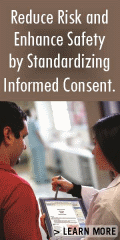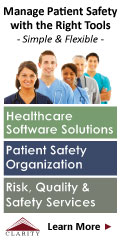 |
 |
 |

July / August 2006
Disruptive Clinician Behavior:
A Persistent Threat to Patient Safety

By Grena Porto, RN, MS, ARM, CPHRM

and Richard Lauve, MD, MBA, CPE, FACPE
Disruptive clinician behavior is increasingly capturing the attention of healthcare providers and leaders and is even making headlines in newspapers. This is due in part to the growing focus on the role of culture as a contributing factor in medical errors. To a great extent, healthcare organizations devoted their initial efforts in patient safety to training and to redesigning clinical processes such as medication administration. However, there is no evidence that error rates have decreased as a result of these efforts, and like the airline industry before it, the healthcare industry has begun to realize that human interaction is an important but largely ignored source of error.
Increasingly, healthcare organizations are devoting efforts to creating a culture of safety, one in which every member of the healthcare team feels safe in voicing opinions and concerns regarding a patient's plan of care and in which the fear commonly associated with reporting errors or disagreeing with those in positions of authority is eliminated. The complementary concepts of teamwork (Wilson, Burke, & Salas, 2005) and high reliability organizations (Weick & Sutcliffe, 2001) have also gained popularity and further underscore the importance of developing cultures in which all members of the healthcare team work collaboratively and respectfully, monitoring and correcting each other's performance and providing input into the team's work and decisions, regardless of power and rank. David Marx's work on Just Culture (www.justculture.org), which outlines guiding principles for preserving individual accountability in a non-punitive environment, has also helped to focus attention on the importance of culture in preventing errors. All of these emerging patient safety practices are clearly at odds with disruptive clinician behavior, and this is causing healthcare organizations and the industry as a whole to re-examine their long-standing tolerance of such behavior. This article examines the nature, frequency, and causes of disruptive behavior, explores why many organizations have been unsuccessful in addressing this issue, and provides guidance for healthcare organizations to adopt a comprehensive plan to eliminate this vexing problem.
What is disruptive behavior?
Anything a clinician does that interferes with the orderly conduct of hospital business, from patient care to committee work, can be considered disruptive. This includes behavior that interferes with the ability of others to effectively carry out their duties or that undermines the patient's confidence in the hospital or another member of the healthcare team. Some specific examples of disruptive behavior, suggested in part by Neff (2000) and expanded on by the authors, include:
- Profane or disrespectful language

- Demeaning behavior, such as name-calling

- Sexual comments or innuendo

- Inappropriate touching, sexual or otherwise

- Racial or ethnic jokes

- Outbursts of anger

- Throwing instruments, charts, or other objects

- Criticizing other caregivers in front of patients or other staff

- Comments that undermine a patient's trust in other caregivers or the hospital

- Comments that undermine a caregiver's self-confidence in caring for patients

- Failure to adequately address safety concerns or patient care needs expressed by another caregiver

- Intimidating behavior that has the effect of suppressing input by other members of the healthcare team

- Deliberate failure to adhere to organizational policies without adequate evidence to support the alternative chosen

- Retaliation against any member of the healthcare team who has reported an instance of violation of the code of conduct or who has participated in the investigation of such an incident, regardless of the perceived veracity of the report
It is important to note that disruptive behaviors are not limited to physicians, although an abundance of literature documents abusive physician behavior. Because of their positions of relative power in healthcare systems, physicians' disruptive behaviors often have a much greater impact on other clinicians and the system as a whole. For this reason, much attention has been directed at physician disruptive behavior and relatively little at such behavior by other members of the healthcare team. It should be noted, however, that disruptive behavior has also been documented to occur with regularity among nurses and pharmacists as well as those working in radiology and the laboratory (ISMP, 2003; Rosenstein & O'Daniel, 2005).
Disruptive behaviors are most often not associated with drug or alcohol impairment, although that connection is frequently assumed by organizations, especially when physicians are involved. Organizations are often tempted to funnel disruptive physician behavior problems to impaired physician committees because they are reluctant to take disciplinary action and believe that the mechanisms in place for dealing with impaired physicians provide a less painful alternative. However, as will be discussed below, this is often a poor choice, since most disruptive physicians are not impaired, the Oakland case notwithstanding. In fact, according to a survey of physician executives conducted by the American College of Physician Executives (ACPE) in 2004, substance abuse accounts for less than 10% of physician behavior problems (Weber, 2004).
What drives disruptive behavior?
It is difficult to know with certainty what triggers these behaviors, but it is likely that the stress of clinical environments is a contributing factor. Healthcare is much more complex today and requires the interactions of a larger number of caregivers and support personnel than in the past. In addition, production pressure is common due to the financial constraints placed on organizations and physicians by decreasing reimbursements and revenues. Workforce pressures have conspired to create an environment in which some members of the healthcare team, particularly nurses, are in short supply. These shortages have led many healthcare organizations to employ short-term staffing solutions, such as use of agency personnel and traveling nurses. This, in turn, undermines the cohesiveness of the team and may also lead to cultural differences among team members that impair effective communication and teamwork. Increased governmental oversight, intrusive managed care regulations, and greater liability risks have also been cited as factors that increase pressure and may contribute to disruptive behavior (Rosenstein & O'Daniel, 2005; Weber, 2004).
In addition, the cultural shift suggested by the patient safety movement from a paternalistic, "captain of the ship" model to a team-based approach with empowerment of and accountability to all team members may itself contribute to perceived loss of autonomy and increase frustration on the part of the more seasoned physicians. All of these factors likely play a role in the increase of work-related stress and the erosion of mutual respect among team members, creating a fertile atmosphere for disruptive behavior to take hold and flourish.
Are physicians the worst offenders?
Disruptive behavior by physicians tends to be driven, at least in part, by their relative positions of power. At a time when hospitals were focused on maintaining the right numbers of physicians, and the attendant admissions generated by them, they began to classify physicians as "customers." Because "the customer is always right," hospitals tolerated a wide variety of aberrant behavior, including resistance to standardization of supplies and equipment, refusal to comply with clinical policies and pathways, and other increasingly disruptive behavior.
Because of physicians' relative positions of power in healthcare organizations, they tend to have a greater impact when they are disruptive. In addition, there is some evidence that physicians are more frequently disruptive than others on the healthcare team (Rosenstein & O'Daniel, 2005). It is also the case that physicians, particularly those who generate high revenues for hospitals, receive more favorable treatment when they are disruptive. Physician disruptive behavior is frequently ignored or tolerated, in part because those responsible for addressing the behavior find it to be a difficult and unpleasant task and because even when they undertake to do so, organizational mechanisms often prove inadequate to solve the problem (Leape & Fromson, 2006; Weber, 2004). Indeed, disruptive physicians are frequently "indulged," as healthcare managers give into their demands simply to shut them up and stop the disruptive behavior. This, in effect, rewards the disruptive behavior and has led to "normalization of deviance," with disruptive behavior becoming an accepted way of doing business for some physicians, and even for non-physicians who imitate the behavior.
What is the frequency of disruptive behavior?
It is unclear whether the problem of disruptive clinician behavior is getting worse, although this is a common perception. Mixed opinions were elicited in both the ACPE survey as well as in discussion on the National Patient Safety Foundation (NPSF) listserv.* It is possible that greater attention to this issue, combined with successful ferreting out of less serious behavioral issues, makes the remaining problems appear much worse. Many researchers agree that disruptive behavior is confined to a small number of clinicians, comprising less than 5% of the total population of clinicians (Weber, 2004; Rosenstein & O'Daniel, 2005; Linney, 1997). However, the Institute for Safe Medication Practices (ISMP) 2003 survey on intimidation raises the possibility that this problem is more widespread than previously thought.
* National Patient Safety Foundation listserv discussion thread entitled "Disruptive clinician behavior," March 21-31, 2006. Available at www.npsf.org.
Physician abuse of nurses is common, with 64% of nurses reporting that they experienced some form of verbal abuse from a physician at least once every 2 to 3 months (Diaz & McMillin, 1991). In the same study, 23% of nurses reported at least one instance of physical threat from a physician, with the most common being having an object thrown at them. Likewise, in a 2002 survey of VHA hospitals, 96% of nurses witnessed or experienced disruptive physician behavior (Rosenstein, 2002).
As mentioned earlier, disruptive behavior is known to occur among many members of the healthcare team, not just physicians. In a 2005 survey of VHA hospitals, 68% of respondents reported that they witnessed disruptive behavior by nurses (Rosenstein & O'Daniel, 2005), and the same study made reference to an unpublished VHA survey that found such behavior in radiology and the laboratory as well. The ISMP survey found that pharmacists were also capable of being disruptive, with some physicians reporting being intimidated by pharmacists.
Disrespect is the most common disruptive behavior exhibited by physicians (Rosenstein & O'Daniel, 2005; ISMP, 2003). More than 95% of physician executives surveyed reported encountering disruptive or potentially dangerous physician behaviors on a regular basis, and the same study also found that disruptive behavior problems almost always involve conflict between a physician and a nurse, physician's assistant, or other staff member and rarely occur between physicians (Weber, 2004).
Subtle intimidation is more common than overt threatening behavior. According to the ISMP survey, the following were the most common of the subtle intimidation behaviors: condescending language or intonation (88%), impatience with questions (87%), and reluctance or refusal to answer questions or phone calls (79%). Overt intimidation behaviors most frequently encountered were: strong verbal abuse (48%), threatening body language (43%), and physical abuse (4%).
What is the impact of disruptive behavior?
One of the most often cited adverse consequences of disruptive clinician behavior is its impact on the workforce, especially turnover. Because of the shortage of nurses, many authors have focused on the impact of physician disruptive behavior on nurse retention. Nurses who are verbally abused report feelings of low self-esteem and worthlessness as well as fear (Diaz & McMillin, 1991). Nurses rate disruptive behavior as the single most important contributing factor to job satisfaction and morale, and 31% said they knew at least one nurse who left because of it (Rosenstein & O'Daniel, 2005). In an early study, 18% of nurse turnover was directly attributed to verbal abuse. (Cox, 1987) Using multipliers of 1.5 to 2 times annual salary commonly used by human resource departments and consultants, the cost of replacing a registered nurse makes the problem of disruptive behavior a significant financial liability for hospitals.
Disruptive clinician behavior has a direct impact on patient safety as well. According to the ISMP survey, 49% of clinicians have felt pressured to dispense or administer a drug despite serious and unresolved safety concerns, and 40% have kept quiet rather than question a known intimidator. Other studies have shown that recipients of abusive behavior learn to cope by avoiding the abuser, even if this means failing to call when warranted and avoiding making suggestions that might improve care (Diaz, 1991; Rosenstein & O'Daniel, 2005; Maxfield, et al., 2005). In one study, 17% reported that an adverse event occurred as a result of disruptive behavior (Rosenstein &O'Daniel, 2005). In a recent USA Today article, Dennis O'Leary, president of the Joint Commission on Accreditation of Healthcare Organizations (JCAHO), stated that wrong site surgery is increasing in frequency (USA, 2006). This problem is attributed in part to refusal by surgeons to comply with preoperative time-out and surgical site marking requirements because of resentment about decreased autonomy and resistance to standardized procedures.
The recent NPSF listserv discussion thread also contained postings from patients and family members of patients who witnessed disruptive behavior by clinicians and whose care was adversely affected as a result. In the Oakland case cited at the beginning of this article, the patient in question was forced to wait until the following day for his surgery due to the surgeon's disruptive behavior. One can only guess what might have happened to the patient if the OR team had allowed the equipment borrowed from the other hospital to be used without being sterilized.
Disruptive clinician behavior has other hidden costs as well. Such behavior tends to decrease the productivity of the unit involved, as was the case in Oakland when the surgery had to be postponed until the following day. It also consumes extensive amounts of administrative time, forcing staff to manage the "post-disruption" turmoil. Policy and procedural change often becomes protracted when disrupters resist those changes, again consuming administrative time and decreasing productivity as "workarounds" persist. Disruptive behavior can also consume material resources, such as when thrown instruments must be re-sterilized or unused supplies discarded due to disruptive behavior. It is widely known that lack of standardization due to physician insistence on autonomy costs hospitals large sums of money annually, particularly in the area of joint replacement, where hospitals costs by far exceed reimbursement for these procedures. It is likely that the true costs of disruptive behavior have not been fully accounted for and contribute to the financial challenges healthcare organizations face.
Why don't current systems work?
As stated above, hospital responses to reports of disruptive behavior are frequently viewed as ineffective. A major reason they fail is that many organizations have not implemented a comprehensive and consistent plan that addresses all the pertinent issues and provides sufficient options for intervention. Instead, most hospitals have policies in place to address only the most egregious behaviors and often ignore patterns of disruptive behavior until they reach dangerous levels. This is especially true for physician "disrupters." In effect, organizations often provide only two alternatives for dealing with disruptive colleagues: the "fly swatter" approach, consisting of counseling the physician not to engage in disruptive behavior again, or the "sledgehammer" approach, which entails severe actions such as suspension and/or termination of privileges, with attendant reports to the National Practitioner Data Bank. Perhaps understandably, a disruptive physician's colleagues are reluctant to trigger a disciplinary process that could have a significant adverse impact on the physician's ability to practice, and thus the "flyswatter" approach is predictably used more often. Thus reports of subtle intimidation, disrespect, and non-responsiveness to patient needs — the most common of disruptive behaviors — are ignored or tolerated until patient injury occurs, at which time the most extreme forms of discipline are undertaken. Indeed, many physicians complain that they were not informed about problems with their conduct until they faced suspension (Leape & Fromson, 2006).
In addition, as mentioned earlier, many organizations try to rely on physician well-being or impairment committees that are designed to deal primarily with impaired physicians. Since most disruptive physicians are not impaired, and the disruptive behavior pattern frequently requires a counseling or disciplinary intervention, this is often a poor fit. Physician impairment and well-being committees are not trained or empowered to deal with disciplinary problems, and tasking them with this inevitably results in a failure to take action.
The reverse situation exists with respect to employees. While many hospitals have clear disciplinary policies in place when an employee fails to perform in the manner expected, there is often little in the way of support and coaching for disruptive employees. It is a fundamental violation of the principles of a safe and just culture to to allow disruptive physicians to choose alternatives to discipline without providing the same resources for employed staff. Similarly, it is a fundamental violation of fairness in the workplace to strictly enforce rules of expected behavior for employees while promoting "normalization of deviance" in cases of physician disruptive behavior. These two violations of the principles of fairness in the workplace contribute greatly to the destruction of organizational morale.
Hospitals often have ineffective mechanisms in place for monitoring compliance that rely almost exclusively on largely ineffective voluntary reporting systems. Since disruptive behavior often produces fear and intimidation, it is unrealistic to expect that voluntary reporting will effectively and reliably identify disruptive behavior. This is aggravated by lack of strong policies and systems to protect those who report or cooperate in the investigation of disruptive behavior.
What should organizations do?
What is needed is a comprehensive, multi-faceted approach that provides a variety of options for dealing with disruptive behavior, depending on severity as well as mitigating factors, such as excessive personal or professional stress, which must also be addressed, but in a different manner. Such an approach would include the following key components:
- Universal code of conduct. The list of disruptive behaviors at the beginning of this article serves as a foundation for crafting a code of conduct that is specific and provides guidance to both clinicians and hospital leadership. While many organizations prefer to craft a code of conduct that is aspirational in tone, the authors have found that it is equally important to clearly describe those behaviors that are unacceptable. Including such a list provides more complete guidance and leaves less room for violators to later argue that their behavior is acceptable. The code of conduct should be identical for both hospital staff and physicians, as well as for patients and their families, guests, and vendors on hospital grounds. The code should be accompanied by any policies, procedures, or regulations to permit it to serve as grounds for dismissal or termination for violators. The code should be developed and modified as needed by an interdisciplinary committee composed of users — nurses, physicians, pharmacists, other support staff, and administrators.

- Planned implementation of a universal code of conduct. In order for the universal code of conduct to become a true source of guidance for both physicians and staff, the organization must execute an implementation plan that properly honors the importance of the code. This requires formal adoption by the medical staff and the hospital, and incorporation into the medical staff by-laws as well as hospital policy. Every staff member and physician must be notified of the adoption of the code and should receive a copy of the universal code of conduct together with training about the code and attendant behavioral expectations. Such training should include guidance about what to do in the event that he or she witnesses behavior that violates the code. Following the training, each staff member and physician should be required to sign a statement of intent to comply with the code of conduct, which should include an acknowledgement that failure to comply may result in disciplinary action up to and including suspension or termination of employment or privileges. The statement should be re-signed by physicians at reappointment and annually by employed staff as part of their performance reviews. This communicates the importance of the code and also provides documentation that can be used to refute later claims made by violators who are disciplined.

- Compliance monitoring. Along with a well-worded universal code of conduct, healthcare organizations must have a well-designed plan for monitoring compliance with the code. This requires a system for detecting code violations that does not rely exclusively on voluntary reporting. Rather, the organization must implement vigorous performance monitoring mechanisms that should include regular surveys of staff, focus groups, peer and team member evaluations, and rounding with direct observation to detect incidents of disruptive behavior. All hospital and medical staff leaders must receive training on how to maintain effective vigilance for code violations as well as appropriate responses. Many instances of disruptive behavior are unreported due to fear (Rosenstein & O'Daniel, 2005). Even in the absence of fear, only about 10% of clinicians express concerns about clinical performance or behavior to a peer, with physicians being somewhat more reluctant than nurses (Maxfield, et al., 2005; Leape & Fromson, 2006). Therefore, organizations must address the inadequacies of voluntary reporting systems and peer monitoring with effective alternatives designed to ferret out and address disruptive behavior problems before patient injury occurs.

- Non-retaliation provisions. The universal code of conduct compliance monitoring system must be complemented by a clear policy of non-retaliation. In addition to incorporating a prohibition against retaliation into the code itself, the organization must clearly spell out its commitment to protect all staff members and physicians against retaliation for reporting of code violations or for participating in investigations of violations. This includes a statement about the penalties for retaliatory behavior, which should be severe.

- Code enforcement. A major reason that disruptive behavior policies are viewed as ineffective by both physicians and hospital staff is that they are rarely enforced (Rosenstein & O'Daniel, 2005). In the 2005 survey of VHA hospitals conducted by Rosenstein and O'Daniel, respondents were asked if their hospitals had participated in a previous survey on disruptive behavior conducted 3 years earlier and whether anything had changed as a result. Only one third of hospitals that had participated in the first survey had taken any action, and only 24% of those reported any improvement.

Hospitals must counteract the corrosive effects of a past history of tolerance and indifference to disruptive behavior, especially on the part of physicians, with consistent, unfailing, timely, yet just responses to code violations. For both physicians and employees, this must include progressive discipline together with screening for mitigating factors, such as excessive stress or illness, and lack of knowledge and experience. However, such mitigating factors should not be presumed to exist nor used as an excuse for inaction, particularly in the case of disruptive physician behavior.

Each instance of disruptive behavior must be investigated and documented by staff trained to discern the severity of the violation, the presence of mitigating factors, and the existence of risk of harm to patients. The investigation should include statements from those involved as well as witnesses, if any. The "disrupter" must likewise be interviewed and given the opportunity to supply information, and this interview should be conducted by the interviewer in the presence of a witness with authority to concur in a recommendation for immediate action, if needed.

Both hospital policies and medical staff by-laws must spell out in detail the steps to be taken in response to a verified report of disruptive behavior. The process should be consistent for both hospital staff and physicians in one key aspect: instances of disruptive behavior that put patients at risk of harm should result in immediate suspension and removal of the perpetrator from the environment in order to protect patients. Of course, medical staff by-laws must contain due process provisions required by law, but under no circumstances should patient safety be sacrificed. In one case, the North Dakota Supreme Court ruled that a cardiologist's suspension for striking a lab technician was "... appropriate when patient safety requires it and bylaws provide adequate standards for summary suspension and a post-suspension hearing process." The court further ruled that the Health Care Quality Improvement Act provided federal standards for such suspensions.

- Flexibility. The hospital must make available resources for coaching and mentoring of both employees and physicians when evaluation of the disruptive behavior indicates that this is the most advisable course of action. In keeping with principles of a culture of safety as well as just culture, the hospital must ensure that it treats both employees and medical staff fairly while maintaining individual accountability for performance. This requires not only swift disciplinary action when warranted, but the withholding of discipline when it is not.

- Oversight committee. A multidisciplinary oversight committee must be appointed to monitor the progress of code implementation as well as code violations. The committee should review not only individual violations but also the pattern of violations to determine system factors that may be contributing to excessive conflict in the work environment. The committee should be empowered to recommend actions to eliminate recurrent sources of tension or conflict in the work environment, including but not limited to measures to improve patient safety, teamwork, collaboration, and communication.

- Preventive strategies. Hospitals should implement known best practices designed to improve relationships between members of the healthcare team. These include standardized and comprehensive conflict resolution strategies to be used by all members of healthcare team and designed to resolve disagreements before they escalate; standardized communication techniques, such as SBAR, which can greatly reduce the friction that often results when nurses call physicians during off hours and which ensures that all pertinent patient information is communicated during handoffs; and formal teamwork training designed to improve collaboration, cross- monitoring, and communication among members of the healthcare team.
Addressing the problem of disruptive clinician behavior requires more than simply adopting policies and educating staff. It requires the organization to:
- undertake a cultural transformation such that each member of the healthcare team is able to function effectively in an atmosphere of respect and collaboration;

- shift away from a model that identifies physicians as customers; and

- stop tolerating disruptive behavior rather than doing the hard work necessary to effectively manage and eliminate it.
In short, organizations must adopt and foster a culture in which all members of the healthcare team, including physicians, are trusted collaborators who, with other members of the healthcare team, serve the true customer — the patient.
Grena Porto is the founder and principal of QRS Healthcare Consulting, LLC (www.qualityrisksafety.com), which specializes in providing customized consulting support to healthcare organizations in the areas of patient safety, risk management, and quality improvement. Prior to forming her own company, Porto served VHA, Inc., first as director of clinical risk management and then as Senior Director of Clinical Consulting. She has over 20 years' experience in all areas of risk management, including loss prevention, risk financing, and claims management. She served as regional claims manager for a large national insurer, and was also director of risk management at a large academic medical center in New York. Porto is a past president of the American Society for Healthcare Risk Management (ASHRM) and has served on the Board of Directors of the National Patient Safety Foundation. Porto is a distinguished fellow of ASHRM and has also attained the designations of associate in risk management (ARM) from the Insurance Institute of American, and certified professional in healthcare risk management (CPHRM) from the American Hospital Association. She holds a bachelor of science degree in nursing and a master of science degree in health administration from the State University of New York at Stony Brook. She currently serves on JCAHO's Sentinel Event Advisory Group and is a member of the Editorial Advisory Board for Patient Safety and Quality Healthcare. Porto may be contacted at gporto@earthlink.net.
Richard Lauve is the founder and principal of L&A Consulting where he assists clients throughout the country with issues of hospital-physician relationships, board-administration-physician team development, clinician team development, and physician leadership. His offerings are designed to develop and secure physician participation in hospital and healthcare system efficiency improvement. Lauve received his medical doctorate from the LSU School of Medicine in New Orleans. After completing an internal medicine residency, he served in the National Health Service Corps for 6 years, practicing solo internal medicine in rural Utah. Lauve received his masters in business administration from the Freeman School of Business at Tulane University. He is a fellow of the American College of Physician Executives, and has received designation from the College of Certified Physician Executive (CPE). Lauve most recently served as medical director and vice president of clinical affairs of the Louisiana, Mississippi, and Tennessee regional office of VHA, Inc. Prior to joining VHA, Lauve was the vice president of medical affairs for Woman's Hospital in Baton Rouge, Louisiana. He also served in the past as the medical director for the faculty practice at LSU New Orleans, and taught ethics and medical management to medical students and residents for 8 years from his position as assistant to the chair of medicine. While at LSU, Lauve also served as the medical director of a 120-bed multi-unit "hospital within the hospital" at Charity in New Orleans and provided consulting services to a wide range of healthcare organizations and professionals. He may be contacted at rlauve@landaconsulting.com.
References
Benzer, D. G., Miller, M. M. (1995). The disruptive-abusive physician: A new look at an old problem. Wisconsin Medical Journal, 94, 455-460.
Cox, H. C. (1987). Verbal abuse in nursing: Report of a study. Nursing Management, 18, 47-50.
Diaz, A. L., McMillin, J. D. (1991). A definition and description of nurse abuse. Western Journal of Nursing, (13)1,97-109.
Institute for Safe Medication Practices (ISMP). (2003). Survey on workplace intimidation. Available at www.ismp.org.
Leape, L. L., & Fromson, J. A. (2006). Problem doctors: Is there a system-level solution? Annals of Internal Medicine, 144, 2, 107-115.
Linney, B. J. (1997). Confronting the disruptive physician. Physician Executive, 23, 55-58.
Maxfield, D., Grenny, J., McMillan, R., Patterson, K., & Switzler, A. (2005). Silence kills. The seven crucial conversations for healthcare. American Association of Critical Care Nurses, VitalSmarts; Available at www.silencekills.com.
Neff, K. E. (2000). Understanding and managing physicians with disruptive behavior. In S. B. Ransom, W. W. Pinsky, J. E. Tropman (Eds.), Enhancing physician performance: Advanced principles of medical management (pp. 4572). Tampa, FL: American College of Healthcare Executives; 2000: 45-72.
Rosenstein, A. H., & O'Daniel, M. (2005). Disruptive behavior and clinical outcomes: Perceptions of nurses and physicians. American Journal of Nursing, 105, 1, 54-64.
Rosenstein, A. H. (2002). Nurse-physician relationships: Impact on nurse satisfaction and retention. American Journal of Nursing, 102, 6, 26-34. USA Today. (2006, April 18). p. 5D.
Weber, D. O. (2004). Poll results: Doctors' disruptive behavior disturbs physician leaders. The Physician Executive, 30, 4, 6-14.
Weick, K. E., & Sutcliffe, K. M. (2001). Managing the unexpected. San Francisco, CA: Jossey-Bass.
Wilson, K. A., Burke, C. S., & Salas, E. (2005). Promoting healthcare safety through training high reliability teams. Quality and Safety in Healthcare, 14, 303-309.
|
 |
 |
 |


















|
 |



